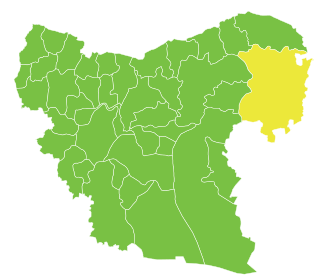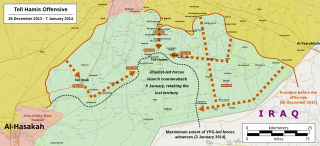Qamishli is a city in northeastern Syria on the Syria–Turkey border, adjoining the city of Nusaybin in Turkey. The Jaghjagh River flows through the city. With a 2004 census population of 184,231, it is the ninth most-populous city in Syria and the second-largest in Al-Hasakah Governorate after Al-Hasakah. Qamishli has traditionally been a Christian Assyrian majority city, but is now predominantly populated by Kurds with large numbers of Arabs and Assyrians and a smaller number of Armenians. It is 680 kilometres (420 mi) northeast of Damascus.

Al-Hasakah Governorate is one of the fourteen governorates (provinces) of Syria. It is located in the far north-east corner of Syria and distinguished by its fertile lands, plentiful water, natural environment, and more than one hundred archaeological sites. It was formerly known as Al-Jazira Province. Prior to the Syrian Civil War nearly half of Syria's oil was extracted from the region. It is the lower part of Upper Mesopotamia.
Tell Tamer also known as Tal Tamr or Tal Tamir, is a town in western al-Hasakah Governorate, northeastern Syria. It is the administrative center of the Tell Tamer Subdistrict consisting of 13 municipalities.
Al-Malikiyah also known as Derik, is a small Syrian city and the center of an administrative district belonging to Al-Hasakah Governorate. The district constitutes the northeastern corner of the country, and is where the Syrian Democratic Council convenes. The town is about 20 km (12 mi) west of the Tigris river which defines the triple border between Syria, Turkey and Iraq. According to the Syria Central Bureau of Statistics (CBS), Al-Malikiyah had a population about 26,311 residents in the 2004 census. Other sources claim that the city has a population of 39,000 as of 2024. It is the administrative center of a nahiyah ("subdistrict") consisting of 108 localities with a combined population of 125,000. The population enjoys demographic and ethnic diversity that is characteristic of most of Al-Hasakah Governorate. The town is inhabited by Kurds, Assyrians, Arabs and Armenians.
Al-Dirbasiyah is a Syrian town on the Syria–Turkey border opposite the Turkish town of Şenyurt. Administratively it is part of the Al-Hasakah Governorate. According to the Syria Central Bureau of Statistics (CBS), al-Dirbasiyah had a population of 8,551 in the 2004 census. It is the administrative center of a nahiyah ("subdistrict") consisting of 113 localities with a combined population of 55,614 in 2004. The majority of the inhabitants of the town are Kurds and Arabs and a smaller Assyrian minority.

Nubl is a small city in northern Syria, administratively part of the Aleppo Governorate, located northwest of Aleppo. Nearby localities include al-Zahraa immediately to the south, Anadan to the southeast, Tel Rifaat to the northeast, Aqiba to the north, Barad to the west, and Mayer immediately to the east. According to the Syria Central Bureau of Statistics (CBS), Nubl had a population of 21,039 in the 2004 census. Its inhabitants are predominantly Shia Muslims and together with nearby al-Zahraa, Nubl forms a small Shia-inhabited pocket in a mostly Sunni Muslim area in the Aleppo Governorate.
Al-Zahraa is a town in northern Syria, administratively part of the A'zaz District of Aleppo Governorate, located northwest of Aleppo. Nearby localities include Tell Rifaat and Mayer to the northeast and Anadan to the south. According to the Syria Central Bureau of Statistics, al-Zahraa had a population of 13,780 in the 2004 census. Al-Zahraa has a predominantly Shia Muslim population and, along with nearby Nubl, forms a small Shia-inhabited pocket in a mostly Sunni Muslim area in the Aleppo Governorate.

Sarrin is a town in northern Syria, administratively part of the Aleppo Governorate, located northeast of Aleppo. It is situated 3 kilometers east of the Euphrates River, south of Kobanî and east of Manbij.
Al-Muabbada is a town in al-Hasakah Governorate, Syria. According to the Syria Central Bureau of Statistics (CBS), Al-Muabbada had a population of 15,759 in the 2004 census. According to the Kurdish news agency "Rudaw", the Ba'athist Party under President Hafez al-Assad changed the name of the town to Al-Muabbada. The town is 35 kilometres from the Iraqi border and 15 kilometres from the Turkish border. As of 2004, Al-Muabbada is the eighth largest town in Al-Hasakah governorate. The majority of the inhabitants of the town are Kurds with a large Arab minority.
Al-Qahtaniyah, formerly Qubur al-Bid, is a town in northeastern Al-Hasakah Governorate, northeastern Syria. It is the administrative center of al-Qahtaniyah Subdistrict, which consists of 103 localities. Historically an Assyrian city, at the 2004 census, it had a population of 16,946. The Female Protection Forces of the Land Between Two Rivers trained in this city.
Bidama is a town in northern Syria, administratively part of the Idlib Governorate, located northwest of Idlib along the border with Turkey. Nearby localities include al-Najiyah to the southeast, Jisr al-Shughur to the east, Shughur al-Fuqani and al-Janudiyah to the northeast. According to the Syria Central Bureau of Statistics, Bidama had a population of 4,162 in the 2004 census. The town is also the administrative center and the second largest locality of the Bidama nahiyah which consisted of 14 localities with a combined population of 18,501 in 2004. Its inhabitants are predominantly Sunni Muslim Kurds
Al-Shaddadah or al-Shaddadi is a town in southern al-Hasakah Governorate, northeastern Syria. The town is the administrative center of the al-Shaddadah Subdistrict, which consists of 16 municipalities. At the 2004 census, al-Shaddadah had a population of 15,806.
Tell Hamis is a town in northeastern Hasakah Governorate, northeastern Syria. The Wadi Jarrah flows through the town. It is the administrative center of the Tell Hamis Subdistrict, consisting of 129 localities.
al-Manajir, often referred to as Manajir, Manajer or Manjar, is a town in northwestern al-Hasakah Governorate, northeastern Syria. At the 2004 census, al-Manajir had a population of 12,156.
Al-Jawadiyah is a town in al-Hasakah Governorate, Syria. According to the Syria Central Bureau of Statistics (CBS), Al-Jawadiyah had a population of 6,630 in the 2004 census. It is the administrative center of a nahiyah ("subdistrict") consisting of 50 localities, with a combined population of 40,535 in 2004.
Al-Hawl, also spelled al-Hole, al-Hol, al-Hool and al-Houl, is a town in eastern al-Hasakah Governorate, northeastern Syria, under control of the Autonomous Administration of North and East Syria. It is the administrative center of the Al-Hawl Subdistrict consisting of 22 municipalities. At the 2004 census, the town had a population of 3,409. Al-Hawl is the site of the Al-Hawl refugee camp.
Khatuniyah is a village near al-Hawl in eastern al-Hasakah Governorate, northeastern Syria.

The Battle of al-Yaarubiyah was fought in late October 2013 at al-Yaarubiyah, a strategically important town at the border of Syria with Iraq. Affiliates of the Democratic Union Party (PYD), namely the YPG/YPJ and local Arab tribes, attacked the settlement in an attempt to capture it from Jihadist and Islamist groups, led by the Al-Nusra Front and the Islamic State of Iraq and the Levant. After four days of heavy fighting, the Islamists were defeated and expelled from al-Yaarubiyah.

The al-Hasakah Governorate campaign was a multi-sided military conflict between Syrian government forces, Kurdish forces, armed Syrian opposition groups, and Salafist jihadist forces, including al-Qaeda's Islamic State of Iraq and the Levant and the al-Nusra Front in the al-Hasakah Governorate as part of the Syrian Civil War. The clashes began with the People's Protection Units (YPG)'s entrance into the civil war in July 2012 and spread across the governorate.

The Battle of Tell Hamis and Tell Brak was fought between the end of December 2013 and the start of January 2014 over control of the town of Tell Hamis and the village of Tell Brak in the al-Hasakah Governorate of northeast Syria during the Syrian Civil War. The armed wings of the Democratic Union Party (PYD), namely the People's and Women's Protection Units, in addition to the Syriac Union Party's Syriac Military Council (MFS), attempted to capture the areas from Salafist jihadists led by the Islamic State of Iraq and the Levant, the Al-Nusra Front, and the Islamic Front's Ahrar al-Sham, but were repelled in a counter-offensive by the jihadists.









